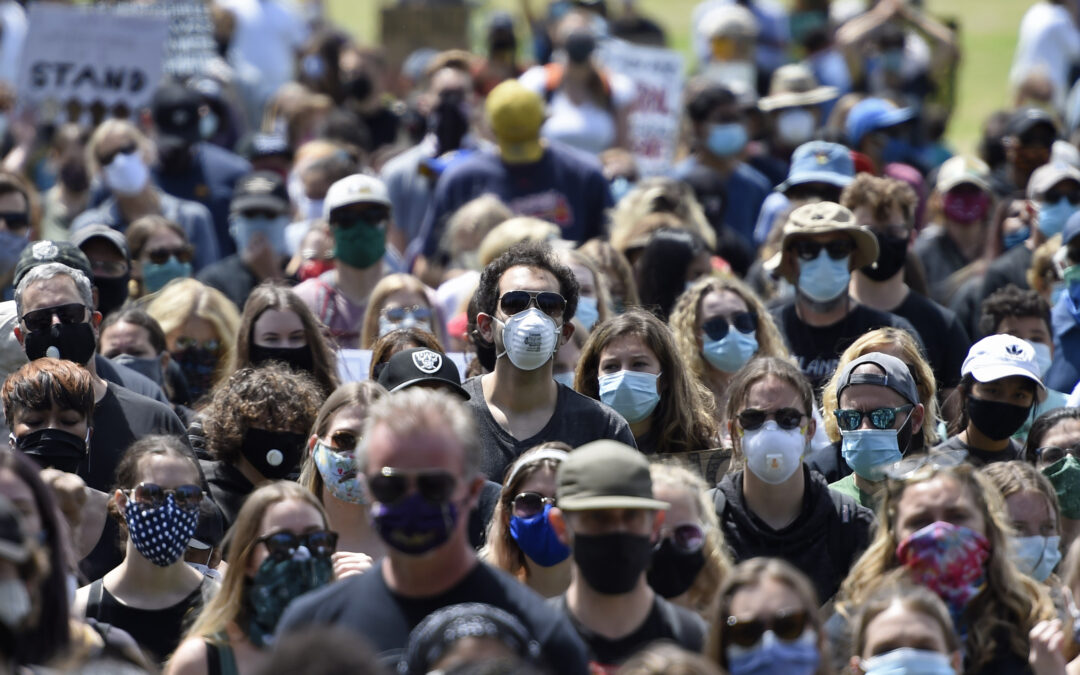Back in April, President Trump picked out a single computer model of coronavirus spread as his oracle of choice.
Unsurprisingly, that simulation initially had rosier estimates than other algorithms, projecting many fewer Covid-19 deaths — and its unconventional calculations and fluctuating estimates drew sharp criticism from epidemiologists.
But the statisticians behind it have since changed their methods, and their new numbers, published Friday, bolster what scientists have long been saying: That doing away with social distancing measures could entail vast numbers of deaths, and that widespread mask-wearing in public could save tens of thousands of lives.
“We think the key point here is that there’s a huge winter surge coming,” Christopher Murray, a lead author on the paper and the director of the University of Washington’s Institute for Health Metrics and Evaluation, said in a press briefing.
At this point, the wave isn’t fully preventable, but “expanding mask use is one of the easy wins for the United States.”
Specifically, the paper projected that there could be some half a million Covid-19-related deaths in the U.S. by the end of February, and that some 130,000 of those tragedies might be forestalled with universal mask use.
But experts warn that the figures from any of the model’s hypothetical scenarios are less useful than the comparison between the different possibilities.
By putting those projections side by side, you can start to see how much of an effect something like mask-wearing might have on a population level, if you take the authors’ estimation that face coverings can reduce an individual’s risk of infection by about 40%.
“The exact numbers are impossible to predict,” said Ruth Etzioni, a biostatistician at the Fred Hutchinson Cancer Research Center and the University of Washington, who was not involved in the new research. “What should drive policy here is the difference between the scenarios with and without masks.”
The IHME team’s initial work last spring didn’t try to model transmission rates and incubation periods of the novel coronavirus, but rather tried to fit the United States onto data from outbreaks elsewhere, and showed a bell-like curve, with cases largely rising and falling symmetrically.
Their projections also wobbled a fair amount, and as Nicholas Reich, a University of Massachusetts, Amherst, biostatistician whose team compares a number of different Covid-19 models, described them to STAT, “were inaccurate and did not reflect the consensus of the modeling community.”
The IHME then switched to a more traditional way of modeling infectious disease, which aims to calculate the mathematical cascade of transmission: the number of people susceptible to the disease, how many of them get exposed, how many then get infected, and how many recover and therefore have at least temporary immunity.
Once the institute made the switch, Reich explained, “their more recent short-term forecasts, which have been submitted to the COVID-19 Forecast Hub, have performed reasonably well in accuracy for up to one month into the future. They aren’t the best model, but they seem to be making reasonably accurate short-term predictions.”
This paper, however, extends beyond that one-month mark, and the further you go into the future, the greater the uncertainty of projections.
The team used state-by-state data from the past on case rates and all sorts of other variables—such as cell phone mobility data, seasonal pneumonia fluctuations, levels of mask use—to then project how tweaking those variables might shift the results.
This sort of analysis is not designed to tell us how effective wearing a mask is at reducing disease spread.
Rather, that is just one of many bits of information that the researchers fed into their model — and their estimate on that front comes from a meta-analysis they did of previous peer-reviewed studies and preprints that looked specifically at that question.
Nor should we expect this model to give any sort of certainty about what the future holds.
“It’s not a forecast per se, because the outcomes are conditional on very specific model assumptions about how effective masks are and how much uptake there is in wearing masks,” Reich said.
Instead, as Zeynep Tufekci put it in The Atlantic, we should use this sort of study for “pruning catastrophic branches of a tree of possibilities that lies before us.”
Because all sorts of policy and behavior changes took place at once, it’s nearly impossible to pick apart the influence of any one strand.
What this sort of analysis can provide is a hint of the general direction we should be headed — and the ones we should avoid — to keep as many people as possible safe.
Given that a scenario in which every single person wears a mask in public all the time results in many fewer deaths than one in which mask use continues at its estimated current pace, one effective course of action seems pretty clear, the authors say.
As unsurprising as their conclusion is, it can still be useful to say it.
“We don’t need a model to tell us that we should all be wearing masks, we don’t need a model to tell us that if we continue the way we’re going, we’re going to see tens of thousands more deaths within the next couple of months,” said Etzioni. “But sometimes when a person provides a model and you see these curves and you see these numbers, it helps appropriately freak you out.”
She added that it might also help bolster public health policy decisions: “A model like this can be very important for our governors who are actually trying to do something to enforce mask mandates. They’re not popular, so politically it can make it tough on a governor who’s trying to do the right thing. Models like this can provide a kind of evidence to support that policy.”
